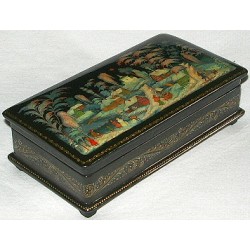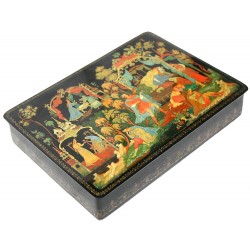No products
Product successfully added to your shopping cart
There are 0 items in your cart. There is 1 item in your cart.
PALEKH
Catalog
New products
-

The Bronze Horseman(Monument to Peter the Great in St.Petersburg), 1965
Arist: Karapaev Yuriy(1936-2009); Size: 9x13.5x5
$425.00 -

The Bronze Horseman(Monument to Peter the Great in St.Petersburg)
Arist: Gordeev V.; Size: 9.5x6.5
$375.00 -

-

-

-

-

-

A little town of Palekh is located in 360 kilometers to the east from Moscow.This is about 60 kilometeres from town of Ivanovo, to which region Palekh belongs.
Palekh was previously a center of icon painting and as such it is mentioned several times in the documents of the 17th century.Icon painting was a family occupation and the craft was passed on from one generation to another.
The Revolution of October 1917 dealt a heavy blow to icon painting in Palekh and throughout Russia. Not only the holy images themselves but the artists who made them became enemies to Communist regime and were persecuted or arrested. As icon and mural paintings were no longer in demand many masters returned to agriculture others tried to go to other handicrafts such as shoemaking, carrier's trading, wickering bast shoes, making toys and dish. Some Palekh masters went to different towns looking for job.
In 1918 the former icon-painters established the First Palekh Co-operative of Decorative Art but it soon fell apart.
In 1922 Ivan I. Golikov being in Moscow saw a black papier-mache box from Fedoskino in the Handicraft Museum.
He painted a papier-mache piece using techniques of icon-painting and technology of the Lukutin lacquer work and had a success.
In 1923 Palekh masters won the first price at the All-Union Exhibition of Agriculture and Industry in Moscow.
Succesful exhibitions of their first works in Moscow and Venice inspired the artists, and on the 5th of December 1924 seven Palekh masters I.I.Golikov, I.M.Bakanov, A.I.Zubkov, I.I.Zubkov, A.V.Kotukhin, V.V.Kotukhin and I.V.Markichev organized an Artel of Ancient Painting.
The new times demanded new themes and subjects. Indeed their paintings abound in peasantry and revolutionary themes, such as reflecting the heroism of the people, reaping, hay making fishing, hunting, circle-dancing, merrymaking, horse-riding. From the very beginning Palekh painters made generous use of folk motives and poetry of Pushkin, Lermontov, Gorky and others.
The most difficult task for Palekh artists was to draw on a thing having form and volume. The range of articles was very wide: brooches, jars, small boxes, bead-boxes, cigarette-cases, snuff-boxes, powder-boxes, panels, glove boxes and so on.
For the transfering the experience of Old masters to young gifted people in 1933 was opened Palekh Art School.
On the 10th anniversary of the Artel on March 1935 came several hundreds of delegates. The Great meeting was opened by a Minister of Education of the Russian Federation. The State Museum of Palekh Arts was opened by the date. The Artel was renamed into Association of Palekh Artists.
Stalin's repressions of 1930-40s and tragedy of Great Patriotic War(World War II) did not pass Palekh artists,they lost some of their talents.
In the 1950s,when many of the first generation had passed away,the development of geniune Palekh was threatened by a learning towards realism which impoverished the poetic language of the painting and could have led to a consequent loss of many stylistic features inherited from Paalekh icon-painting.The changes that soon after that began in Soviet society helped Palekh to stand firm.Palekh College graduates of the late 60s and early 70s started a revival by turning back to the sources of Palekh.This generation has in many respects outlined the main features of today's Palekh and is paving the way for it's future development.The influx of gifted young people promises further development and prosperity in Palekh Art.
In the 1960s many talented painters arrived at Palekh and among them there were Boris Yermolayev, Nikolay Golikov, Alexey Kochupalov, Anatoliy Peskov, Valentin and Tatiana Khodovs, Alexander Klipov, Stanislav Butorin, Gennadiy Kochetov, Irina Livanova, Nina Bogachyova. In the 1970s Vladimir and Natalie Buldakovs, Nikolay Gribov, Yuriy and Yekaterina Schanitsyns, Vadim Zotov, Anna Kamanina, Nikolay Lopatin, Lubov Nekrasova, Olga Subbotina joined them. All of them took the traditions of Palekh seriously and started working them out imaginatively. The 1980s can be called the period of the renaissance of Palekh Art with their names.
Nowadays there are several different co-operatives and Workshops successfuly working in Palekh.
Based on Vadim Shchanitsyn's Book-"Palekh and Palekhians"1994, published by Zet Industrial Co.
PALEKH There are 375 products.
Happy Family
This pieceful composition was created with true passion for subject by Palekh artists, Sergey and Maria Gurilyev. This husband and wife artistic team is well known for their dedication to detailed imagery.Here the artists have depicted a scene of a family relaxing on a bank of pond.
$450.00In StockTale of a Golden Fish
This classical composition that shows us an episode from a "Tale of a Golden Fish"was painted by a Palekh artist Ivan Vikhrev. Here we can see the very beginning of the story, where Fisherman cath the Golden Fish and she asked about his wishes to exchange them to her freedom.Also we can see that the Fisherman and his wife lived very poor.
$295.00In StockTale of a Sleeping Princess
This profound presentation of genuine Russian artistry has been created by N. Bogachyova from the village of Palekh. It features several well detailed scenes from the Russian classic tale "Tale of a Sleeping Princess" written in verse by Alexander Pushkin.
$425.00In StockBoating Down the River
Yevgenia (Zhenya) Shatokhina is the artist who painted this romantic scene.
$295.00In StockParting
This splendid Palekh box has been painted by Olga Kolygina. The work is called "Parting", and shows the parting of a maiden with a brave warrior who is going to defend his motherland from an enemy.
$375.00In StockScarlet Flower
This small Palekh box has been drawn by Nina Bogachova whose favorite themes to depict are folklore and genre scenes. Collectors love her work for its mood, and for its dynamic and flexible appearance.
$350.00Out of stockTale of a Sleeping Beauty
This traditional Palekh box has been skillfully painted by Yevgenia Shatokhina (or "Zhenya" for short, as she signs the piece). Here she has chosen to depict several scenes from the popular story of, “The Sleeping Princess and Seven Bogatyrs” written by A.S. Pushkin.
$375.00In StockBy the Pike's Will
This traditional Palekh box is a creation of Yevgenia (Zhenya) Shatokhina. It depicts a scene from the Russian tale, "Emelya and the Magic Pike". Here we can see Emelya who approaches the tsar's palace riding a stove.
$375.00In StockPouring Water
This inspirational composition is an original by Palekh artist Marina Alexeevna Denisenko, who has a gift for painting religious scenes and symbolism. There is a great sense of power in her work, and although she works with egg-tempera paints she is able to use them like oil paints. When working on new and exciting compositions she always pours her entire...
$379.00In StockThe Swan Lake
This is a passionate example of exquisite Russian artistry. The colors caress the theme depicted, the inner contours and accompanying decoration are well executed compliments. Marina Denisenko is the experienced artist that developed this charming composition. Her work is always a fine ambassador of the village of Palekh.
$299.00In StockAt the Water Mill
This attractive round box has been painted by Larisa Mazurina from the village of Palekh. Mazurina was born in 1974 in the village of Palekh, Ivanovo Region where she resides at present. In 1994 the artist finished the Palekh Art School. Her teachers were V.V. Buldakov and T.I. Belousova. Her favorite themes to depict are fairy-tales and landscapes.
$299.00Out of stockVillage Winter Fun
Yevgenia Shatokhina of Palekh is the artist who painted this beautiful winter scene. Cold light blue colors are used to paint the snow-covered areas while the crowns of some trees and the architecture are drawn in warm pink, brown and orange tones. This color contrast is very beautiful. Gold and aluminum paint is used throughout the scene to outline and...
$399.00In StockThe Forest Spirit
Yevgenia Shatokhina of Palekh is the artist who painted this beautiful box. Yevgenia (or "Zhenya" for short, as she signs the piece)has a beautiful style that is classic Palekh, but at the same time exhibits a unique flair.
$175.00In StockAt the Well
Larisa Mazurina of Palekh has created this composition displaying two peasant woman filling their pails with water at the well. The scene is thoroughly detailed with gold and aluminum paint.
$425.00In StockWinter Village
Yevgenia Shatokhina of Palekh is the artist who painted this beautiful box. Here she depicts villagers enjoying the simple pleasures of winter. Yevgenia (or "Zhenya" for short, as she signs the piece) has a beautiful style that is classic Palekh, but at the same time exhibits a unique flair.
$375.00In StockWinter Fun
This oval box has been created by Bokova Irina from the village of Palekh. It features the traditional theme of a Russian winter troika. The troika rushes along the village street passing by peasants and their houses.
$495.00 $850.00Reduced price!In StockHow the Goat went to the Kitchen-Garden...
This box was created by Olga Tsyganova from the village of Palekh. It features the fair, and certainly the merchants with their goods and the buyers. The main heroine of the composition is the peasant woman who came to the fair to sell her goat.
$450.00In StockThe Sleeping Beauty
Nina Bogachyova from the village of Palekh is the talented miniaturist who handcrafted this stunning piece of artistic expression.
$1,650.00In StockElegance
Marina Denisenko never ceases to amaze fans of lacquer art. There is a great sense of power in her works, and although she works with egg-tempera paints she is able to use them like oil paints.
$595.00In StockTale of a Frog Princess
This attractive unique-shaped box is a creation of Vladimir Bogdanov (born 1956) whose favorite themes to depict are folklore and genre scenes. This talented artist is a participant of various exhibitions since 1985. His works are kept in the Art Fund of Russian Federation!
$550.00In StockTale of a Tsar Saltan
This originally-shaped box was painted by a well-known and experienced Palekh artist, Vladimir Bogdanov. The box's lid and its sides show some recognizable moments from Pushkin's "Tale of Tsar Saltan".
$999.00In StockPlay of checkers
Interesting wooden needle-holder from a founder of Palekh Lacquer Miniature Art-Ivan Golikov. All needed paper work is possible to get from the Museum.
$59,000.00In StockSummer time!
This peaceful scene has been painted by Yvgeniya Bonokina from the village of Palekh. This box shows a summer activity of Russian villagers.
$650.00In StockTachanka
The box is constructed out of paper-mache. Black lacquer covers the exterior and red lacquer covers the interior of the box.
$450.00In Stock


























